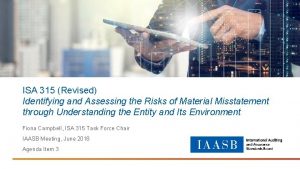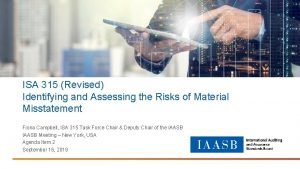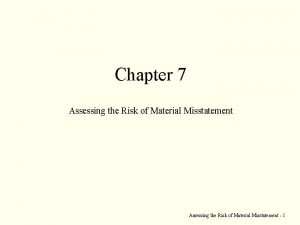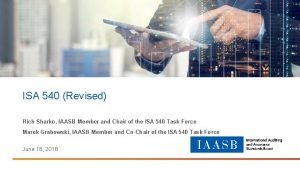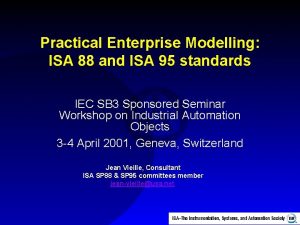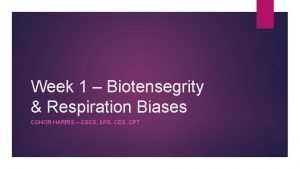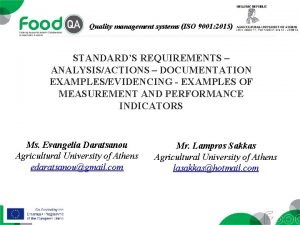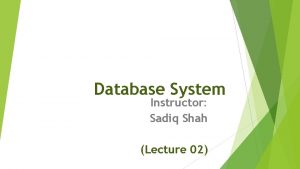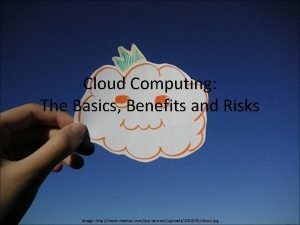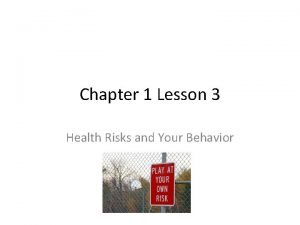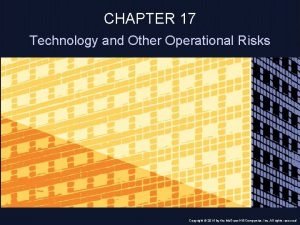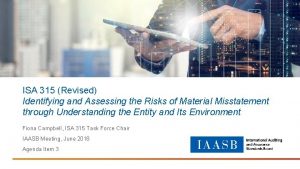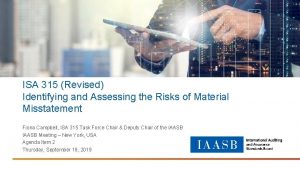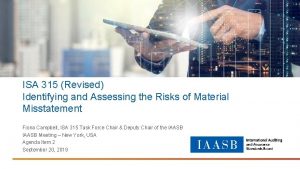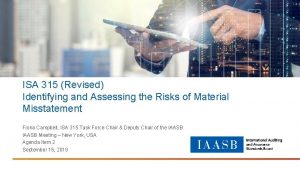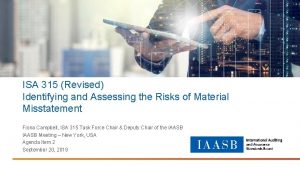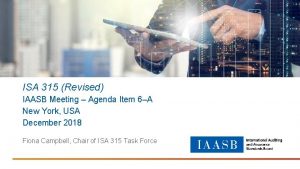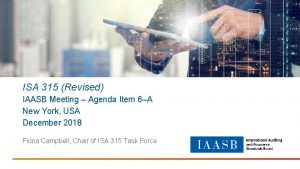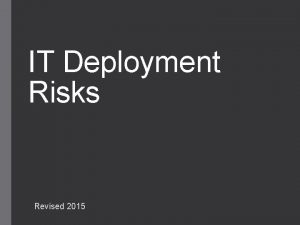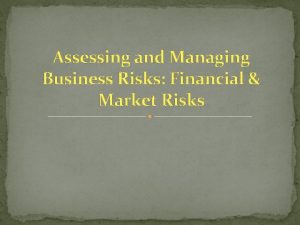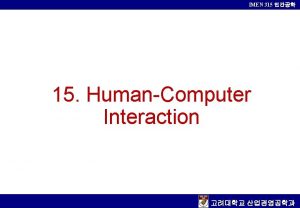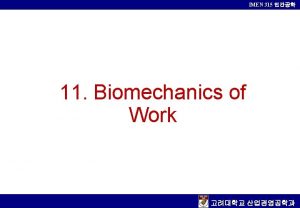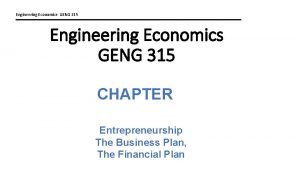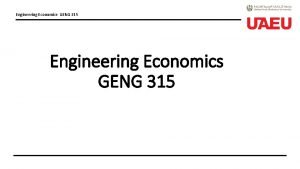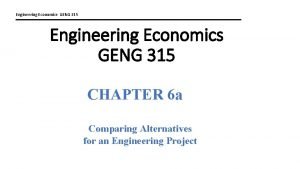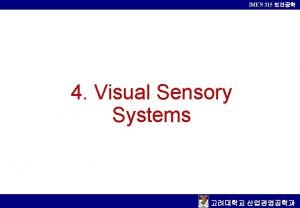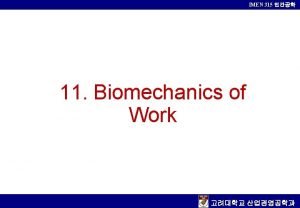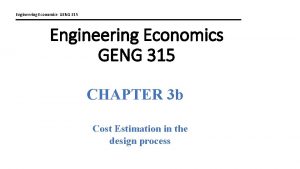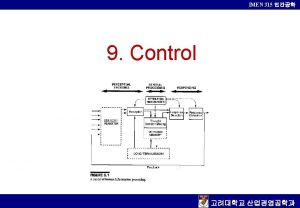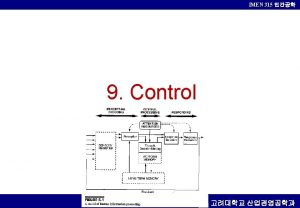ISA 315 Revised Identifying and Assessing the Risks























- Slides: 23

ISA 315 (Revised) Identifying and Assessing the Risks of Material Misstatement Fiona Campbell, ISA 315 Task Force Chair & Deputy Chair of the IAASB Meeting – New York, USA Agenda Item 2 September 16, 2019

Page 2

ISA 315 (Revised)‒NEW in September • Introductory paragraphs • Public sector • Automated tools and techniques ‒ Supported by Technology Working Group Q&A • Translations • Effective date Page 3

Summary of CAG Representatives Comments • Broadly supported the changes to address understandability and length; a few concerns about use of tables • Significant risk definition – “Combination” of likelihood and magnitude – should it rather be the ‘intersection’ – Clarify ‘in rare circumstances’ where may not be a significant risk • Inherent risk factors – supportive of changes to use fraud risk factors • Paragraph 39(a)(ii) is confusing, and may go further than intended in particular in relation to documentation • Threshold for identifying risks of material misstatement – description in revised ISA 200 conforming amendments clearer • SMP Committee Representative thanked the IAASB for the opportunity to input to the revisions; encouraged that the standard is finalized but had the view that a longer implementation period is needed • Majority CAG Representatives would like standard finalized (i. e. , no re-exposure) Page 4

Offline Comments – Significant Aspects for Further Consideration • Definition of relevant assertions • Hanging paragraph – Para 17 • Inherent risk factors and the way we describe consideration of the inherent risk factors in paragraph 23(c) • Paragraph 39(a)(ii) • Threshold for identifying risks of material misstatement (ISA 200 CA) Page 5

ISA 315 (Revised) Question 3 What are the Board’s views about: • Definitions • Requirements • Application material • Appendices Full standard presented in clean – Agenda Item 2 -E (The Task Force Chair will walk through the standard – relevant paragraph numbers to follow) Page 6

ISA 315 (Revised)‒Introductory Paragraphs Par # Paragraph # 2 -10 Introductory paragraphs Relevant Application Material: - Effective Date & Objective to be added back Page 7

ISA 315 (Revised)‒Definitions Par # 16(b) – 16 Definitions Application Material Assertions to IT environment A 1 – A 6 Relevant Assertions to System of Internal Control A 9 – A 10 (g) 16(h) – 16(l) Page 8

ISA 315 (Revised)‒Risk Assessment Procedures and Related Activities Page 9

ISA 315 (Revised)‒Understanding the Entity & Its Environment / Applicable Financial Reporting Framework Par # Requirements Application Material: A 46 a – A 78 (Entity & 23 Understanding the Entity and Its Environment and the Applicable Financial Reporting Framework its Environment) A 79 ‒ A 82 (Financial Reporting Framework) A 88 a ‒ A 88 d (IRFs) 24 Evaluating the Entity’s Accounting Policies Page 10

ISA 315 (Revised)‒Understanding the Components of the Entity’s System of IC Par # Requirements Understanding the Components of the Entity’s System of Internal Control 28 30 ‒ 31 31 A Application Material A 89 – A 104 a Control Environment, Risk Assessment Process & Entity’s Monitoring of System of IC A 104 a – A 104 d Understanding the Entity’s Control Environment A 106 – A 114 b The Entity’s Risk Assessment Process A 117 – A 120 The Entity’s Process for Monitoring the System of Internal Control A 123 – A 135 c Page 11

ISA 315 (Revised)‒Understanding the Components of the Entity’s System of IC Par # 36 Requirements Application Material Information System and Control Activities Components A 135 d – A 135 m Understanding the Entity’s Information System and Communication A 135 n – A 159 a A 160 – A 177 39 Control Activities Component A 179 a – A 189 (IT) A 194 – A 200 (D&I) 43 Deficiencies in the Entity’s System of Internal Control A 200 a – A 200 c Page 12

ISA 315 (Revised)‒Identifying & Assessing the Risks of Material Misstatement Par # Requirements Identifying and Assessing the Risks of Material Misstatement 45, 47, Identify and Assessing Risks of Material Misstatement 48 Application Material A 201 – A 206 a – A 207 e (financial statement level) A 208 – A 221 (except A 211 – A 214) & A 226 – A 228 (assertion level) A 221 a – A 225 (spectrum of risk) 46. Determine Relevant Assertions and Significant Classes of Transactions, A 211 – A 214 Account Balances and Disclosures Page 13

ISA 315 (Revised)‒Assessing the Risks of Material Misstatement Par # Requirements Application Material 49 Determining Significant Risks A 228 a – A 229 b 50 Determining Whether Substantive Procedures Alone Cannot Provide Sufficient A 231 a – A 231 e Appropriate Audit Evidence 51 Assessing Control Risk A 232 – A 235 a Page 14

ISA 315 (Revised) Evaluating Audit Evidence from Risk Assessment Procedures Par # 51 A Requirement Evaluating the Audit Evidence from Risk Assessment Procedures Application Material A 239 a – A 239 c Stand-back Par # 52. Requirement Application Material Stand-back – Material Classes of Transactions, Account Balances or Disclosures A 240 – A 242 that have Not Been Identified as Significant Classes of Transactions, Account Balances or Disclosures Page 15

ISA 315 (Revised) Revision of Risk Assessment Par # 53 Requirement New Inconsistent Information Application Material A 243 Documentation Par # Requirement Application Material 54 Documentation A 244 – A 248 Page 16

ISA 315 (Revised)‒Appendices Page 17 | Confidential and Proprietary Information

Effective Date Question 2 What are the Board’s views about the proposed implementation date? Page 18 | Confidential and Proprietary Information

ISA 315 (Revised) ‒ Conforming Amendments ISA Conforming Amendments 200 Overall Objectives of the Independent Auditor and the Conduct of an Audit in Accordance with International Standards on Auditing 240 The Auditor’s Responsibilities Relating to Fraud in an Audit of Financial Statements 330 The Auditor’s Responses to Assessed Risks 540 (Revised) Other Auditing Accounting Estimates and Related Disclosures Various – Supplement to Agenda Item 2 -I Page 19

www. iaasb. org For copyright, trademark, and permissions information, please go to permissions or contact permissions@ifac. org.

Changing the interpretation of “could” in Definition of Ro. MM and re-defining Significant Risks


 Isa 315 revised
Isa 315 revised Isa 315 summary
Isa 315 summary While assessing the risks of material misstatement
While assessing the risks of material misstatement Identifying and non identifying adjective clauses
Identifying and non identifying adjective clauses Whats an adjective clause
Whats an adjective clause Information essential
Information essential Isa 540
Isa 540 Isa 88 procedural model
Isa 88 procedural model Wide infrasternal angle
Wide infrasternal angle Opportunity and challenges in media and information
Opportunity and challenges in media and information Ways to address grammar in the writing classroom
Ways to address grammar in the writing classroom With ppst domain 5 in mind
With ppst domain 5 in mind Iri reading assessment
Iri reading assessment Assessing a new venture's financial strength and viability
Assessing a new venture's financial strength and viability Assessing leadership and measuring its effects
Assessing leadership and measuring its effects Module 4 topic 5 turnabouts and parking
Module 4 topic 5 turnabouts and parking Module 4 topic 1 assessing and managing risk
Module 4 topic 1 assessing and managing risk Actions to address risks and opportunities
Actions to address risks and opportunities Costs and risks of database approach
Costs and risks of database approach Chapter 1 lesson 3 health risks and your behavior
Chapter 1 lesson 3 health risks and your behavior Cloud computing benefits and risks
Cloud computing benefits and risks Related risks that increase in effect with each added risk
Related risks that increase in effect with each added risk Chapter 1 lesson 3 health risks and your behavior
Chapter 1 lesson 3 health risks and your behavior Technology and operational risk
Technology and operational risk
